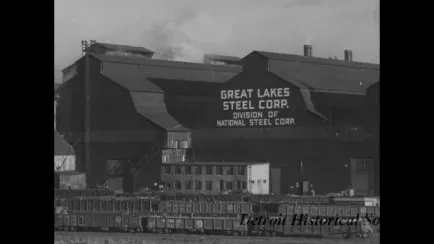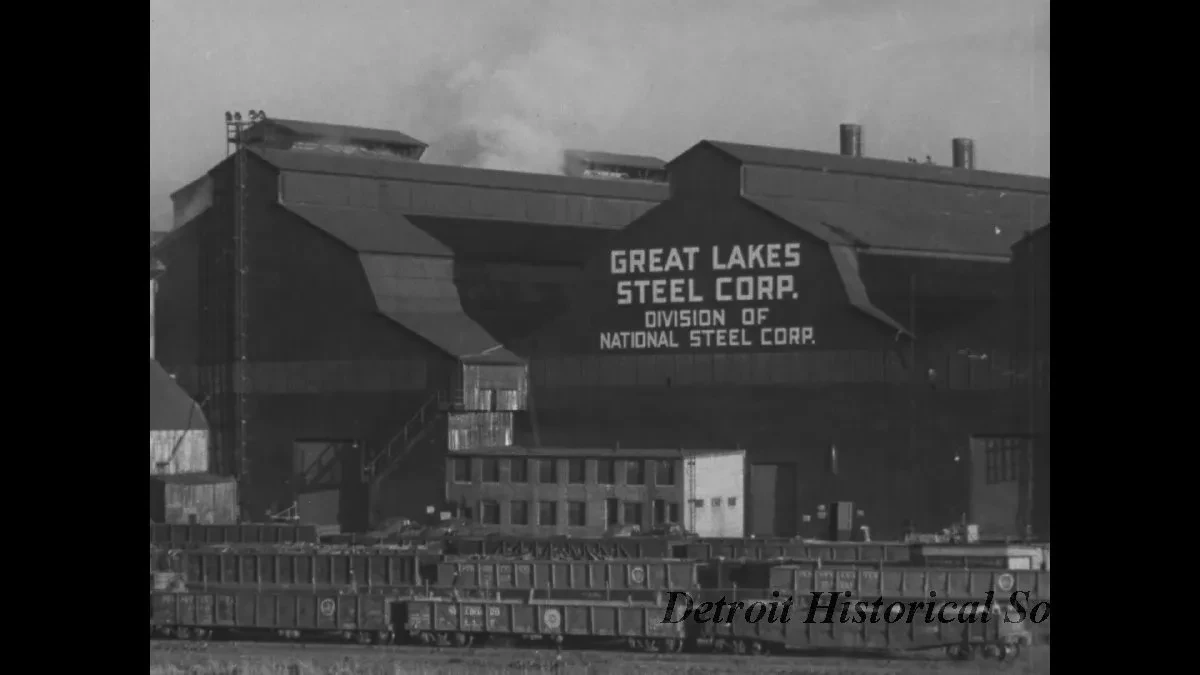Film, Motion Picture
Master Print
"Men and Mills"
3-31-50
Fred Crady
16mm black and white film "Men and Mills," produced by Marshal Templeton for the Great Lakes Steel Corporation about the company's steel mills on Zug Island. The film consists of footage of the factories, the milling process, and the workers, accompanied by a narrative voice-over.
The film's introduction consists of scenes tracing the steel making process from piles of iron ore to the foundry, as the narrator provides a poetic voice-over. Following the title cards, there's several exterior shots of the complex leading to a sequence that shows the furnaces of the plant in dramatic operation, as well as a series of close-ups of the plant's workers.
The next section concerns the role of the Detroit River. This sequence includes a shot overlooking the Canadian Steamship Lines freighter GLENELG, as well as a shots freighters passing in front of the downtown skyline. As the narration turns toward the city's automotive industry, there are several shots of workers and machinery at an automotive parts stamping plant. The focus then returns to shipping on the river, with shots of freighters passing downtown and the mill complex.
Next the narrator discusses iron mining operations around Lake Superior over a series of shots showing an open pit mine, and then ore docks in Duluth, Minnesota. This latter portion includes footage of the National Steel Corporation freighter GEORGE R. FINK first at the ore dock, then leaving Duluth Harbor.
As the narrator continues discussing freighters, a N.M. Paterson and Sons Limited freighter is shown on the Detroit River with the city's skyline in the background. The narrator then mentions that with the amount of steel being used by Detroit's industries, there was an opportunity for a still mill in the city. This is accompanied by shots of workers stacking and cutting steel sheets.
The narrator then speaks in general about the filling in of marsh land and the construction of the mills over construction footage. Footage follows of the complex's exterior, of the furnaces at work, of the workers, and of finished spools of steel.
The film then launches a lengthy portion tracing the process from iron ore to steel ready for manufacturing. This opens with the arrival of iron ore by freighter, which is then unloaded by buckets and cranes. The National Steel Corporation freighter FRANCIS E. HOUSE is pictured here, as are the workers and machines that perform the unloading process. The ore is placed in piles, and the ore from those piles is moved by crane onto railroad cars bound for the stock house, as is limestone, and coke. A carload of coke is show passing through the quenching house for cooling. A skiff hoist is then used to deposit the mix of coke, limestone, and ore into the top of the blast furnace. At the bottom of the furnace, workers are shown channeling the molten metal into thermos cars bound for the main plant.
Within the plant, the cars pour their contents into a ladle which is then moved by crane into the mixer. This portion of the film focuses on the skill of the crane operator in performing this task. Molten iron form the mixer is then poured via rail car into the Bessemer convertor. The narrator explains how a pair of workers--the regulator and the blower--control the convertor to purify the molten metal. Once the process is complete, the convertor then pours the blown metal into a ladle on a conveyor where it goes to the open hearth furnaces.
Outside the furnaces, scrap and limestone are loaded onto a train and ferried into the open hearth building. Workers are shown operating the furnace to melt the scrap and limestone. Then the blown molten metal is brought in and skillfully poured into the furnace. Workers with shovels then create dykes of cinder lag around the furnace doors. Workers monitor, adjust, log the temperature as the process occurs. Eventually workers tap the hearth, and the molten steel gets separated from the slag as it pours out into a pair of large vessels. The molten steel is then ferried by crane into the ingot mold line where it is then poured into large molds.
Next, the molds are then moved by rail to the stripper building. A crane removes the mold casing from the steel which has been formed into giant ingots, and then these ingots are then moved to the soaking pits to equalize their temperature. Workers are again highlighted here. One is shown adjusting and monitoring air and fuel supplies the soaking pits, another records information about the process, and yet others control the pit covers and cranes. One such crane is shown removing the ingot, which is then conveyed to the blooming mill.
Here, the workers use the bloomer to reduce the ingot into an elongated slab. This slab is then cut, conveyed to the slab cooling yard, and then labeled by a worker. Next, workers use oxygen torches to remove surface imperfections in the scarfing process. The slabs are then reheated and conveyed into the steel mill.
In a single long tracking shot, an overhead camera follows a slab as it goes through the scale breaker for washing, the spreading mill to compresses it, the universal roughing mills, and the friction driven rolls. It then approaches the finishing mill. Following a cut, workers at the finishing mill are shown operating the machinery, and taking measurements using an optical pyrometer. The film then takes us briefly away from the step-by-step milling process, to show the plant's generators in the motor room. The narrative returns to the milling process with the steel strips moving through the rotary flying shear.
The hot strip coiler then rolls the steel, which is then processed in pickling vats, then cut and recoiled. Then are then moved to the cold reduction mills, where we again get a series of shots focusing on the role and expertise of the workers here. The rolls are then softened in the portable annealing furnace, then retempered in the skin pass mill, before finally being shipped out on the back of trucks.
Next, in a series of shorter segments, the film highlights some other products the mills create. First, steel billet is showing being processed through bar mill stands, then merchant mills, before being coiled and conveyed to the inspection stands. Next in the strand steel division, steel coils are shown getting shaped and welded into the elements for prefabricated Quonset buildings. Then workers at bloomer are shown processing ingot into mile-long ribbons of steel.
The films conclusion features some exterior shots of the complex from the river, as well as shots of workers, and parts of the processes previously shown.
The film is housed in a brown metal tin labeled, "Master Print, 'Men and Mills,' 3-31--50" in yellow paint marker, and "Fred Crady" below in red marker.
Request Image

